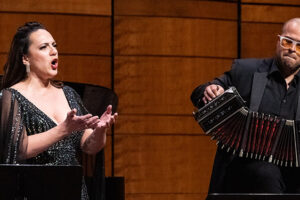

But while its creators have claimed the piece was inspired by the magical realism of Gabriel Garcia Márquez (the libretto was written by his student, Marcella Fuentes-Berain), I would argue that the piece owes more to Ovid’s Metamorphoses than anything else. I write this because Florencia en el Amazonas is, above all, an opera about movement, change, and transformation: to travel from point A to point B, and how such a journey alters the contours of one’s identity.
While this evolution is not always painless, it is unavoidable. And as much as the characters both long for, and eschew, change within the opera, they have no choice but to confront these notions head on, whether they want to or not. As the ship’s captain tells his nephew, Arcadio: “Se avanza, siempre se avanza.” Indeed, things always move forward.
At its most basic level, what is perpetually moving forward in Florencia is the El Dorado, which sails down the Amazon River from Leticia to Manaus so that its passengers may hear the opera diva, Florencia Grimaldi, perform. However, what five of these characters do not realize is that the famed singer is, in fact, among them in disguise (of course…), a fellow traveler. While the others are heading to Manaus in search of Florencia, Florencia is also in search of an aspect of herself—she wishes to reconnect with a man she loved in the past, a butterfly hunter named Cristóbal Ribeiro da Silva, whom she left behind in Manaus to pursue her career.
But Florencia is not the only character hoping to make sense of the transforming nature of time and travel. Other figures in the opera also must contend with change. A young couple, Rosalba and Arcadio, slowly acknowledge their growing attraction for one another, while also coming to terms with love’s inherent pain. In contrast, a middle-aged couple, Paula and Alvaro, reckon with their own cooling passions. Meanwhile, the captain of the El Dorado and his helper, Riolobo, must navigate the Amazon’s natural and spiritual dynamics.
The manner in which these characters negotiate change is given both physical and temporal dimensions. And the river, always in a state of flux, symbolizes this progress. These mythical and physical processes of change explicitly call to mind the dynamics of Ovid. In fact, at the end of the opera, unable to enter Manaus because of a Cholera epidemic, Florencia processes her grief by transforming into a butterfly—the object of her former beloved’s affection.
Catán’s roving score is suitable for an opera about change. While deploying melodic strains reminiscent of Puccini, the composer also evokes the rushing water within the orchestration. Moreover, the opera’s final scene seems a nod to Strauss—alluding to the transformation of Daphne, as well as the final monologue from Capriccio. The result is a sweetly palatable (if a tad derivative) score, extremely accessible, and suitable to the demands of the opera’s narrative.
That being said, it is easy to see how some might find Catán’s opera a bit cloying. Not long ago, critic Philip Kennicott wrote, “…the closest narrative comparison [to Florencia en el Amazonas] is the old Saturday-night television pairing of The Love Boat and Fantasy Island.” And Kennicott is not wrong. The opera bears all the hallmarks of those TV shows: accessible, emotional, and perhaps a bit sappy. But it’s hard not to be seduced by sugar if one has a sweet tooth. And to certain operagoers, Kennicott’s comparison might seem like nothing more than a cynical bah humbug.
NYCO’s production, directed by John Hoomes, is a relatively successful embodiment of this sweetness: well lit, well costumed, and, generally, well sung. An original production of Nashville Opera, the direction makes significant use of projections, moving images of what appear to be the actual Amazon River. This device, constantly in motion, invests the piece with an ongoing kinetic energy.
Toward the end, however, as the opera’s subject matter becomes more mystical and supernatural, these projections become a bit ham-fisted. This is especially true of Florencia’s transformation scene—what begins as a beautifully symbiotic fusion of flesh and technology, suddenly becomes cheap and eerie, evoking the famous poster for Silence of the Lambs.
What is more distracting, though, is the way in which dancers are used to enact the organic movement of the river. Dressed like Woody Allen’s sperm in Everything You Wanted to Know About Sex* (*But Were Afraid to Ask), they writhe on the stage throughout the performance. And while I understand the desire to highlight the river’s constant, organic movement, the unfortunate costumes evoke oversized maggots instead.
Other performers fair better. As Florencia, Elizabeth Caballero does an admirable job of commanding the stage. Her voice, suffering a few technical hiccups early in the evening, is capable of deep pathos and emotional heft.
The rest of the cast supports the diva reliably. Won Whi Choi as Arcadio and Sarah Beckham-Turner as Rosalba display strong vocal presence and clear, direct character development. While their growing awareness of a mutual attraction is awkwardly staged, their passion for one another remains convincing. Their foils, Lisa Chavez and Luis Ledesma as Paula and Alvaro, produce even singing and garner sympathy, despite their thankless roles within the opera’s plot.
However, as the ship’s captain, Kevin Thompson struggles with intonation, and he is generally indistinguishable. As his helper, the magical Riolobo, Philip Cokorinos lacks the necessary charisma the role demands. This is especially true of a key moment in which he transforms into some kind of blue moth. While the moment is meant to spark wonder and awe, it instead suggests a superhero gone to seed.
The orchestra, briskly led by Maestro Dean Williamson is often out of tune—however, the musicians cannot dampen the shimmer and ardor of Catán’s score, which always pulses forward, in sync with the river’s motions. There is something incredibly compelling about this dynamic. And as the ship reaches its destination to discover the cholera epidemic—coffins floating on the water’s surface—one can see quite clearly the destination of all moving things, and hence the opera’s inevitable end: death, the grief it provokes, and its ultimate capacity for transformation.
Photo: Sarah Shatz























Comments